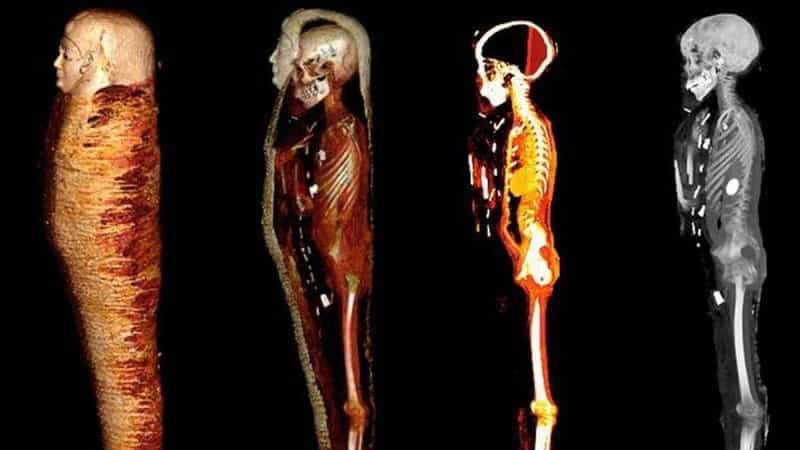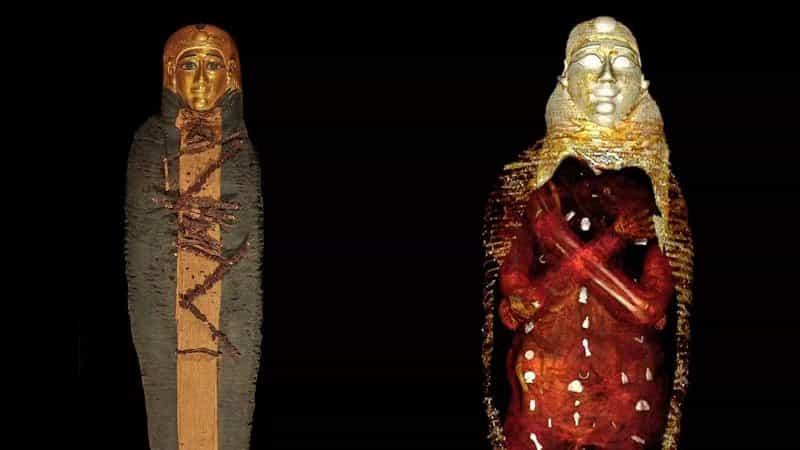“Golden Boy” Mummy Found in Egyptian Museum Basement
A mummy that was forgotten for over a century in the basement of the Egyptian Museum in Cairo has been discovered to have 49 amulets, many of them made of gold, hidden among its bandages.
The mummy, estimated to be that of a 15-year-old of high social status, was found in 1916 in a Ptolemaic-era cemetery in southern Egypt and had been stored in the museum’s basement, unnamed.
A recent scan revealed the treasure, earning the mummy its new nickname “Golden Boy.” It is now on display in the main exhibition hall of the museum. The body was found inside two sarcophagi, one made of gold with Greek inscriptions and one made of wood, and a golden mask covered the face.
A CT scan was conducted to examine the body, and the results indicate the teenager likely died of natural causes. The findings have been published in the scientific journal Frontiers in Medicine.
30 Gold Amulets Found in Ancient Egyptian Mummy
The most surprising discovery in the mummy is the 49 amulets it contains, with 30 being made of pure gold, some made of semi-precious stones, and others made of simpler materials like baked clay and earthenware. Parts of the body even had been replaced with gold, such as the tongue.
Ancient Egyptians considered gold to be a sacred material as it did not corrode and ensured protection for the individual in the afterlife. Gold was also believed to be the flesh of the gods.
Each amulet had a specific purpose in the journey through the underworld to achieve eternal life. For example, the golden tongue ensured the deceased could speak in the afterlife.
If this was not replaced, a less expensive alternative was to place gold leaf on top of the tongue. It was also crucial to place a scarab, also made of gold, on top of the heart, as it prevented the heart from speaking against the deceased during the Osiris trial.
Possible Macedonian Origin of the “Golden Boy” Mummy
The rediscovery of this intact mummy is significant as it provides insights into the Ptolemaic era’s burial practices and ancient Egyptian beliefs about the afterlife (323-30 BC). It offers an understanding of how the dead were buried during the period following Alexander the Great‘s death until the fall of the Ptolemaic dynasty to the Romans.
In addition to the amulets, the mummy also has a garland of ferns. Dr. Sahar Saleem, the principal investigator of the study and a radiology specialist, explains that ancient Egyptians believed in the sacred and symbolic effects of plants and flowers, and they would place them next to the deceased during burial and offer them during festivals at the grave.
A revealing detail of the mummy is that it has an uncircumcised penis, a practice performed by ancient Egyptians but not Greeks. This could indicate that it belonged to royalty.
The Ptolemaic dynasty, which ruled Egypt for nearly 300 years, was of Macedonian origin, but adopted certain customs from ancient Egyptian pharaohs, although maintaining Greek practices in personal aspects like circumcision.
The groin incision to remove the organs is also evident, with an amulet placed near the penis to protect the incision.
The mummy had been long forgotten in the basement storage of the Egyptian Museum in Cairo, until its recent examination using CT scans. It was dubbed as “the golden boy” due to the numerous golden amulets found among its bandages.
The museum management decided to showcase the mummy in the main exhibition hall, where visitors can now see the mummy and related images from the CT scans, along with a replica of the heart scarab, which was 3D printed. The identity of the mummy’s owner remains unknown.
Source: Abel GM, National Geographic









